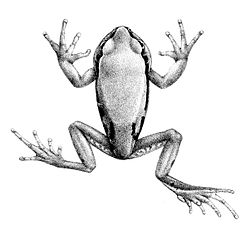Description
Adult males measure 20–45 mm (0.79–1.77 in) and adult females 40–63 mm (1.6–2.5 in) in snout–vent length; size varies considerably among populations. The dorsal colour is almost always green. Darker markings may be present but only very rarely form a triangle. There is a lateral series of large, dark brown blotches. Skin of the dorsum is rather coarsely granular, sometimes warty. Males have pectoral glands. The tadpoles are eel-shaped, heavily pigmented, and can grow to 64 mm (2.5 in) in length. [3]
The male advertisement call is a single, deep "clack", sometimes preceded by a creaking sound. [3]
Habitat and conservation
Leptopelis gramineus typically inhabits montane grasslands, sometimes Afro-alpine moorland or even forest margins [1] and montane forests. [3] It can also occur in rural gardens and human settlements. [1] It occurs at elevations between 1,900 and 3,900 m (6,200 and 12,800 ft) above sea level. [1] [3] It is a fossorial species. Reproduction takes place in pools and small streams, both permanent and temporary. [1]
This species is common to abundant at suitable sites. Because of its adaptability, it is not considered being significantly threatened by environmental degradation caused by human settlement and small to large-scale agriculture. Chytrid fungus is common in the area, but its impact on this species is unknown. It occurs in the Bale Mountains National Park (although the park offers limited protection only). [1]
This page is based on this
Wikipedia article Text is available under the
CC BY-SA 4.0 license; additional terms may apply.
Images, videos and audio are available under their respective licenses.

